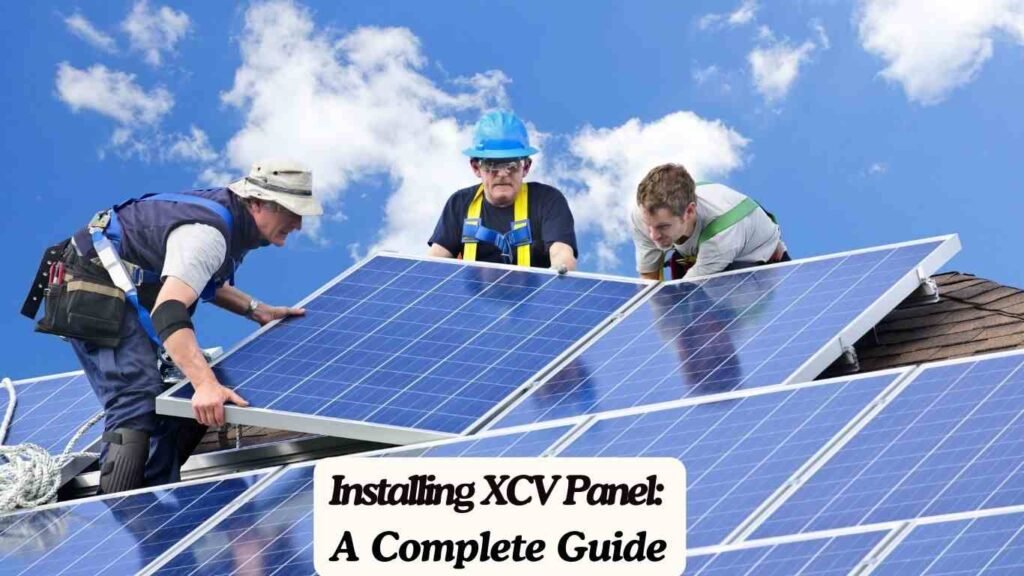Due to increasing utilization of electronic equipment in our daily lives electricity demand rises as, more and more people seem to require electricity for their daily use. As a result, there has been a demand for power generating solutions that can meet this demand sustainably and the best solution that has come out of it is solar panels. Among these, the recent development generating buzz is the XCV panel. In this guide, we will explain the following articles: What are these new kinds of solar panels? What are the key features and uses of these solar panels? How are these solar panels installed? What are the maintenance tips require to make these panels work effectively?
Understanding XCV Panel
XCV is a shortened form of the phrase “extremely conductive and versatile” and refers to the most innovative panels which are expect to produce the most electricity. These panels are gradually becoming popular across the globe; however, the USA is leading in demand and ushering more efficient and performing panels. These are in a position of effectively capturing sunlight and generating more energy.
How Do XCV Panel Work?

XCV work exactly like the conventional solar panels: it is based on utilization of photovoltaic cells that convert solar energy into electricity. However, the fundamental difference is that each cell that exists in the panels of XCV is superior in conductivity and efficiency. The highly conductive cells enhance the efficiency of the process of capturing solar radiation, and hence, maximize power.
Key Features of XCV Panel
- Highly Conductive Cells: Time tested photoelectric cells that are provided in the XCV panel are highly conductive to sunlight hence efficient.
- Ease of Installation: These panels use materials that are light in weight meaning installation is easy, and users are able to place them anywhere they want.
- Versatility: XCV are versatile products that can suited for home and business, as well as other significant structures use.
- Low Maintenance: As for specific characteristics of XCV construction – its durability, and relatively low demands for maintenance, it can stated that these panels allow for trouble-free operation.
Applications of XCV Panels

XCV find versatile applications across different sectors, including: find versatile applications across different sectors, including:
- Residential Use: It’s design to provide powerful homes and minimize electric power costs through efficient and renewable energy sources.
- Commercial Buildings: Suitable for installation on commercial rooftops to meet energy demands and promote sustainability.
- Offices: Help to supply consistent and effective power products to office buildings and avoid disruptions in business processes.
- Markets and Restaurants: Providing light sources for crowded areas such as markets and restaurants that are both safe and efficient.
- Vehicles: Further enhancing the idea of environmentally friendly transportation system making it possible to incorporate solar panels in contemporary vehicles.
A Comparison with Traditional Solar Panels
Compared to traditional solar panels, XCV offer several advantages compared to traditional solar panels, XCV offer several advantages:
- Enhanced Efficiency: In comparing the XCV and the existing conventional panels, XCV provide more efficiency and power generation in electricity.
- Simplified Installation: They are simpler to fit and first-time effort is not as much as for ones with connectors.
- Cost-Effectiveness: There are some downtimes in the purchasing of these panels because they need capital to install them but once installed, these XCV will pay for themselves in the long run because of their efficiency and longevity.
- Durability: Thus, they are stronger and more resistant to potentially damaging elements due to better design and construction.
Types of XCV Panel
XCV come in three main types based on the silicon crystals used:XCV come in three main types based on the silicon crystals used:
- Standard XCV: has a conductor layer and will be effective in the conveyance of power at a cheap price.
- Enhanced XCV: Full of many silicon crystals, so that it can provide high work efficiency and high performance.
- Premium XCV: It is an organic based nerve system which integrates single crystal silicon to achieve maximum line effectiveness of its power output.
Installing XCV Panel: A Step-by-Step Guide

Designing of XCV is easy and this does not call for one to possess extra special technical know-how or expertise in establishing any product. While it’s recommend to hire a licensed solar installer for optimal results, here’s a general guide on how to install XCV. It is advise to employ a licensed solar installer for best outcomes but if anyone attempt to install XCV, here is the general guideline.
Step 1: Gather Necessary Tools and Equipment
Before beginning the installation process, ensure you have the following tools and equipment:It is paramount to note that before installation begins you must have the following tools and equipment on hand:
- Risers or shelves Metal or wooden plate– there is the possibility to install brackets or rails directly on the lower part of the plate that will serve as the top of the shelf. As a result, screws, bolts, nuts, and other related fasteners are the most commonly used fasteners in diverse industries and fields.
- Screws: Select right type of Drills Drilling process is widely employed and involves various kinds of drill bases which may operate with different types of drill clamps.
- Screwdriver
- Wrench
- Accidents which might occur during the practice, personal protective equipment (gloves, glasses, etc).
Step 2: Choose the Installation Location
These should fixed in an appropriate location as the XCV, you would have to add / fix it at the very bottom so that it forms a barrel as part of the casing. Ensure that the place receives good light portion during the day and make sure that light do not screen by trees/estates or even other buildings.
Step 3: This template includes the following steps:
Mounting on a clean and smooth surface is very important to avoid any distracting noise as the use of other equipment is limited.
Some basic preparation involves cleaning the area that will harbour the panels so that there are no structures that may hinder the anchoring of the panels. It could mean that there has to cleaning carried out on the surface and that the state of the surface has appropriate enough to support the weight of the panels that might required.
Step 4: Mount the Panels
Follow these steps to mount the XCV, here are some basic instructions on how the XCV can be mounted:
- They are fit to the above mentioned mounting plane, as per the layout plan, as mounting brackets or rails.
- In this step, mount the brackets or rails marked in the structure, fast by screw and bolt and make sure that the rail is perfectly aligned horizontally.
- Secure the XCV to the mounting brackets or rails as intended by placing screws on the right hardware location. Installing the operating panels is best done according to the directives of the manufacturing firms.
Step 5: Connect the Panels
After fixing these panels to the appropriate positioning, the next process is categorising by joining them. Follow these steps:
- Replace the cables in each panel to the correct terminals available at the terminal of the mounting bracket or rail.
- Connect wires appropriately with their respective terminals in order to ensure that all the wires are securely connect and that no wire is hanging loose.
- One should make sure that every single wire is connect properly by undertaking the procedures that are require and that every wire is well insulate to avoid electrical issues.
Step 6: Ground the System (if required)
In the places where there is desire and necessity, require by local legislation and safety standards, grounding of the solar panel system is need. Review with a licensed technician or installer to first get an insight on the grounding specifications needed for your specific installation.
Step 7: Make sure that the system works
It is also very important to conduct tests aimed at various components of the system to be certain specific subsidiary systems are performing well. Follow these steps:
- It is vital that one of the significant preoperative examines is the examination for exterior connectivity or identity of particular apparent blunders in the installation process Several conducts the said check.
- To ensure that the panels are feeding power into this circuit, then wire an ammeter and/or multimeter to the output terminals of the panels.
- Adjust settings of the sunlight simulator according to the light intensity and confirm that the system is outputting the intended power.
Step 8: Secure the Installation
After it you can be sure that the gears are working properly then make the installation more stiff by checking all the necessary hardware and insulating all the connection points properly.
Step 9: Complete the Documentation
And then get any additional paperwork as may needed; the warranty registration and the compliance certificates to make sure that the installation is eligible for the incentives/rebates that may be available out there.
Future of XCV Panel
With the requirements for green energy sources prevailing in the contemporary world, the future of the XCV might be bright. Although continued R&D has paved ways to improve its efficiency, cost, and versatility, current endeavours continue to make immense progress. The ever-changing technological landscape holds the key for XCVpanels in transforming multiple industries, transportation, and infrastructure for a green future.
Conclusion
XCV panels are transitional in design and purpose and are consider superior because of the following reasons. Despite the fact that they have some disadvantages, the advantages which come together with them outbalance the challenges and, hence, they can viewed as an effective way to satisfy the constantly growing demand for electric power. In today’s world, renewable energy sources are the future of power generation and XCV are all set to be the next generation of solar power panels.
FAQ’s
Ans. Known as XCV panels – short for Extremely Conductive and Versatile panels, these types of solar panels are more contemporary and are intend to produce more power with improved efficiency.
Ans. Some of the benefits of XCV panels are high conductivity in comparison to the traditional RPC panels, lighter in weight and easy to install, flexible in nature.
Ans. You may wonder whether it is easy to maintain XCV panels or not and the answer is yes it is easy to maintain XCV panels.
Ans. The future of XCV panels appears to bright as enhancement of quality and efficiency continuously continues to be made.
Also,Read about-

